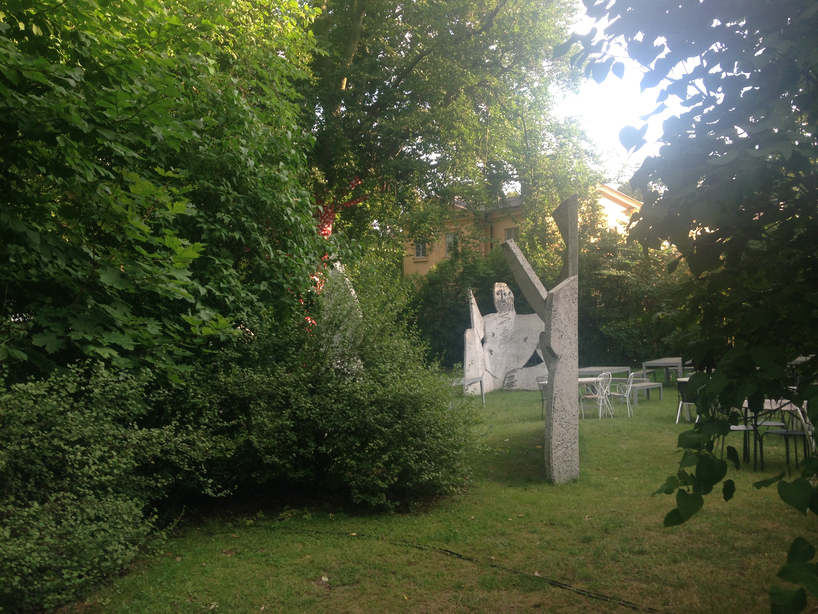The garden at the Moderna Museet is a garden for a future – even a post-future! – which had already passed into history when I arrived in 2011. I spent much of that summer contemplating this paradox through the lens of the presence and resonating echoes of Frukost i den Gröna and Paradiset. Even more, the colorful story of the Bucky Dome which had been erected in the garden illuminated the recently past century, as I both programmed and played concerts with Fylkingen, Bengt Carling and the collective that formed to celebrate Don Cherry’s music that year. That former future’s gardens gave brutalism a momentarily kind hand. The kaleidoscopic was spun into minimalist tetrahedra for the building of a new kind of world. Nostalgia has been rightly classified as everything from illness to dangerously folly. But perhaps there is more subtle ore hidden in the same complexities that looking to the past sometimes refutes, to be wrested from its beguiling flowers, winnowed and carried into imagined futures to come. Here, then, is a sonic garden to echo the physical one, built from recordings of Stockholm’s few remaining marks of industrial life, together with choirs, violins, harpsichords, plant life and other moments in the fabric of the city where the garden lives, utilizing Supercollider and the Buchla and Serge synthesizers at EMS (the Elektronmusikstudion, or the Electronic Music Studio in Stockholm)
Audiorama commissioned this installation as part of the 2016 Stockholm Music and Arts Festival.
Three art history students, who were working at the festival guiding the public through the art exhibitions came and spoke to me for an hour about the installation. I was overjoyed to find that they understood exactly what I was trying to convey. We talked about gentrification, the shift away from industrial places in cities, nostalgia, the passing of the old century and Detroit (which is an hour away from my hometown by car). It was an enormously positive experience, and convinced me to continue to pursue work with the Ghost Installations.
Virvelns trädgård (The Garden of Verticils). Tracks bounced from Supercollider program used to model the installation.
IMPORTANT: This version is made for HEADPHONES, not for a pair of speakers; please use headphones to listen!
This installation was built with mp3 players and consumer-grade speakers, water-proofed in case of rain during the three days it would be up. Instead of batteries, we had dedicated electricity, and the mp3 players were enclosed in plastic food containers sealed with duct tape. This meant that the speakers were much better than those I was able to use for the Ghost Installations, and the volume was exactly where I hoped it would be.
The sound files were all from the library of field recordings I have collected in and around Stockholm over the last years. This was a conscious decision- to go more deeply into material I already had, rather than generating more. The only new sounds I created were violin and synthesizer phrases, meant to evoke the same nostalgia for 20th century modernism as the garden itself does.
I divided the sounds into the following categories: Archaic, Choirs, Gold Seeds, Metallic Flowers, Nautical, Sad Piano, Stone, Trains, Violin. Some of these categories had additional separations where some of the files were processed with Buchla, Serge, or a program containing cascading envelope generators in Supercollider. I then used another program in Supercollider to structure the groups using different random weighting for the sound-files in each group’s selection and occurrence. This second program was based on my first attempts to write a supercollider program to run ghost installations, which was then taken up and generously re-written by David Granström. This new (and better in every possible way) version was originally made for a collaborative installation we both participated in elsewhere in 2014. I have been using that program to model Ghost Installations ever since.
I made four ”players” in Supercollider to emulate each of the four mp3 players. Each category of sounds had its own routine, controlling how often sound files would be selected and played, and how their volume, pitch, envelope, panning and direction would be altered. I then tried to work out on paper how many extra copies of each file and how many silences of which lengths would be needed on each mp3 player to at least partially emulate the program. After arriving at numbers that seemed right, I wound up with a combined total of 1433 sound-files and empty (silent) files on each player. The players were each connected to two speakers, and set to loop on random shuffle. Since many of the sound-files were spatialized in stereo, and they were duplicated on all four players, this was a ”poor girl’s” way to mimic both supercollider’s randomization capabilities and a kind of primitive spatialization.


